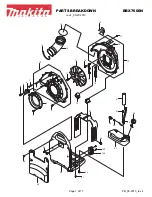
61
Exhaust Vent Requirements
•
It will remove dissipated heat that is produced by the ICP torch and RF power
supply. The venting system should provide a flow rate of at least 3398 L/min
(120 CFM). The temperatures of the exhaust gases upon exiting the instrument
are about 200 °C (392 °F) at 1500 watts of RF power.
The venting system should provide a flow rate of at least 3398 L/min (120 CFM).
The temperatures of the exhaust gases upon exiting the instrument are about 200
°C (392 °F) at 1500 watts of RF power.
The exhaust duct is connected directly to the top of the Avio 500 instrument and it
is recommended to use the 4-inch (10.16 cm) I.D. flexible ducting provided to
make the final connection to the instrument with stainless steel tubing for the rest
of the exhaust ducting. The blower capacity depends on the duct length and the
number of elbows or bends used to install the system. If an excessively long duct
system or a system with many bends is used, a stronger blower may be necessary
to provide sufficient exhaust volume. Alternatively, smooth stainless-steel tubing
may be used instead of flexible stainless-steel tubing where flexibility is not
required to reduce system friction loss or “drag.” A length of smooth stainless-steel
ducting has 20-30% less friction loss than a comparable length of flexible ducting.
When smooth stainless-steel tubing is used, elbows must be used to turn corners.
These elbows should turn at a center line radius of 150 mm with a maximum bend
angle of 45 degrees to reduce friction losses, and the number of elbows should be
minimized.
Warning: Toxic fumes
The use of ICP-OES instruments without adequate ventilation to outside air may
constitute a health hazard. For example, the combustion of halogenated
hydrocarbons produces toxic vapors. Extreme care should be taken that exhaust
gases are vented properly.
Avertissement: Des fumées toxiques
L'utilisation d'instruments d'ICP-OES sans ventilation adéquate à l'air extérieur
peut constituer un danger pour la santé. Par exemple, la combustion
d'hydrocarbures halogénés produit des vapeurs toxiques. Un soin extrême doit
être pris que les gaz d'échappement sont évacués correctement.
!
Warning
Summary of Contents for AVIO 500
Page 1: ...AVIO 500 Customer Hardware and Service Guide ICP OPTICAL EMISSION ...
Page 2: ......
Page 3: ...Avio 500 Customer Hardware and Service Guide ...
Page 12: ...Contents 10 ...
Page 30: ...28 ...
Page 31: ...C h a p t e r 1 ...
Page 32: ......
Page 33: ...Safety Practices 1 ...
Page 58: ...56 Safety Practices ...
Page 59: ...C h a p t e r 2 ...
Page 60: ......
Page 76: ...74 Preparing Your Laboratory ...
Page 77: ...C h a p t e r 3 ...
Page 78: ......
Page 79: ...System Description 3 ...
Page 115: ...C h a p t e r 4 ...
Page 116: ......
Page 137: ...135 Installing the Quick Change Adjustable Torch Module 1 2 10 8 9 3 4 7 6 5 ...
Page 152: ...150 Installation Figure 4 22 Scott Spray Chamber Clip Assembly in Place ...
Page 195: ...193 Shipping Lists 09290798 USB Cable Table 4 6 Spares Available Continued ...
Page 196: ...194 Installation ...
Page 197: ...C h a p t e r 5 ...
Page 198: ......
Page 217: ...215 Quick Change Adjustable Torch Module 1 2 10 8 9 3 4 7 6 5 ...
Page 316: ...314 Maintenance ...
Page 317: ...C h a p t e r 6 ...
Page 318: ......
Page 342: ...340 Troubleshooting Figure 6 5 Injector too far forward ...
Page 344: ...342 Troubleshooting Figure 6 7 Air leak or spray chamber temperature too high ...
Page 346: ...344 Troubleshooting ...
Page 354: ......
















































